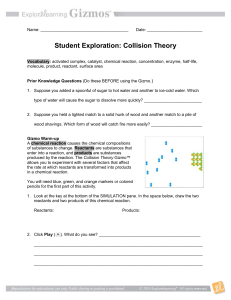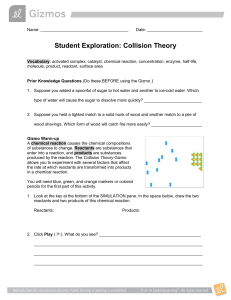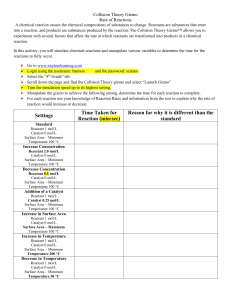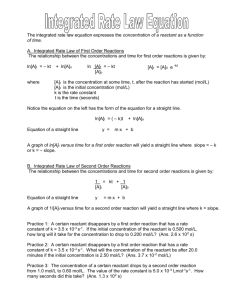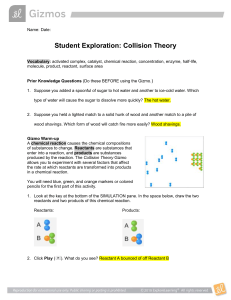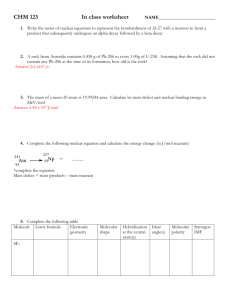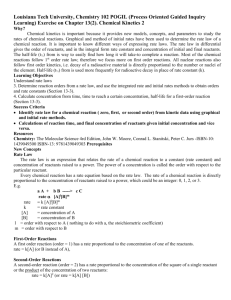Student Exploration Sheet: Growing Plants
advertisement
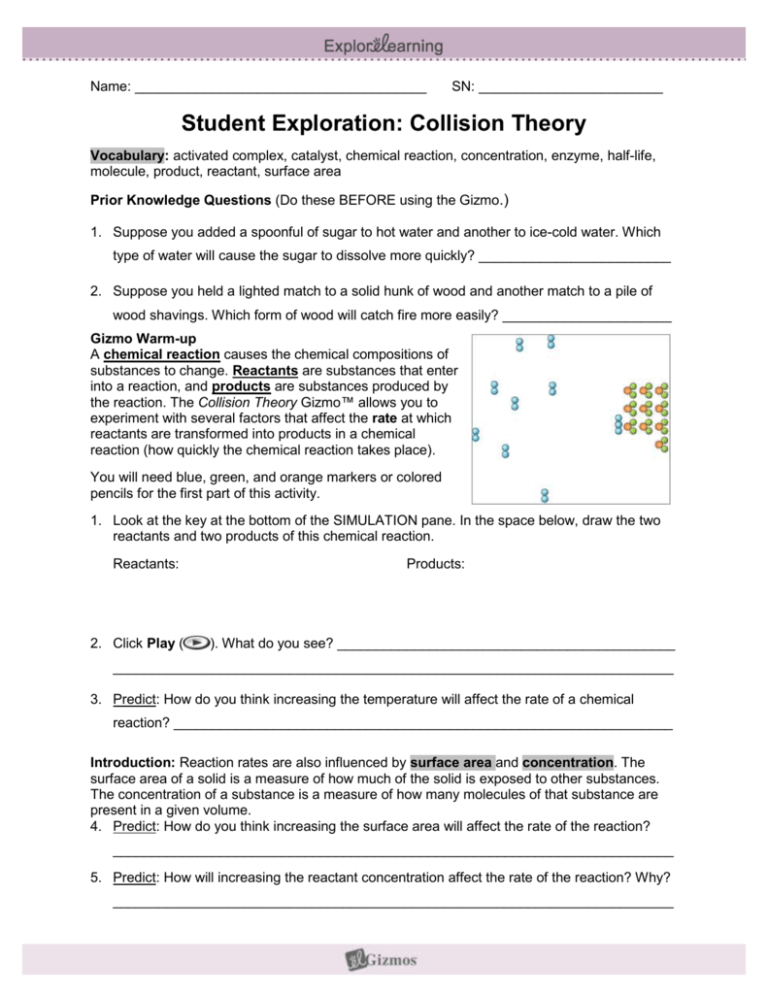
Name: ______________________________________ SN: ________________________ Student Exploration: Collision Theory Vocabulary: activated complex, catalyst, chemical reaction, concentration, enzyme, half-life, molecule, product, reactant, surface area Prior Knowledge Questions (Do these BEFORE using the Gizmo.) 1. Suppose you added a spoonful of sugar to hot water and another to ice-cold water. Which type of water will cause the sugar to dissolve more quickly? _________________________ 2. Suppose you held a lighted match to a solid hunk of wood and another match to a pile of wood shavings. Which form of wood will catch fire more easily? ______________________ Gizmo Warm-up A chemical reaction causes the chemical compositions of substances to change. Reactants are substances that enter into a reaction, and products are substances produced by the reaction. The Collision Theory Gizmo™ allows you to experiment with several factors that affect the rate at which reactants are transformed into products in a chemical reaction (how quickly the chemical reaction takes place). You will need blue, green, and orange markers or colored pencils for the first part of this activity. 1. Look at the key at the bottom of the SIMULATION pane. In the space below, draw the two reactants and two products of this chemical reaction. Reactants: 2. Click Play ( Products: ). What do you see? ____________________________________________ _________________________________________________________________________ 3. Predict: How do you think increasing the temperature will affect the rate of a chemical reaction? _________________________________________________________________ Introduction: Reaction rates are also influenced by surface area and concentration. The surface area of a solid is a measure of how much of the solid is exposed to other substances. The concentration of a substance is a measure of how many molecules of that substance are present in a given volume. 4. Predict: How do you think increasing the surface area will affect the rate of the reaction? _________________________________________________________________________ 5. Predict: How will increasing the reactant concentration affect the rate of the reaction? Why? _________________________________________________________________________ Get the Gizmo ready: Activity A: Temperature Click Reset ( ). Check that the Reactant concentration is set to 1.0 mol/L, the Catalyst concentration is set to 0.00 mol/L, and the Surface area is Minimum (CONTROLS tab). Question: How does temperature affect the rate of a chemical reaction? 1. Observe: Select the ANIMATION tab. View the animation with No catalyst selected. What do you see? _______________________________________________________________ _________________________________________________________________________ When two reactant molecules meet, they form a temporary structure called an activated complex. The activated complex breaks up into the product molecules. 2. Observe: Return to the CONTROLS pane. Set the Temperature to 0 °C and the Simulation speed to its maximum setting. Click Play. Now set the Temperature to 200 °C. What do you notice about the chemical reaction at the higher temperature? _________________________________________________________________________ 3. Gather data: Click Reset. A useful way to compare reaction rates is to record the time required for half of the reactants to react, called the half-life of the reaction. With the Temperature set to 200 °C, click Play. Click Pause ( ) when the number of reactant molecules is 10. Record the half-life time in the first space of the table below. Trial 200 °C 150 °C 100 °C 50 °C 1 2 Mean halflife Repeat the experiment at different temperatures to complete the table. 4. Calculate: Calculate the mean (average) half-life for each temperature. Hint: To get an average, add the two numbers of minutes together and divide by 2, record as the mean minutes. Then add the two numbers of seconds together and divide by 2, record as the mean seconds. If you end up with more than 60 seconds, subtract 60 from the number of seconds and add 1 to the number of minutes. 5. Analyze: What do your results indicate? _________________________________________ _________________________________________________________________________ 6. Draw conclusions: For two molecules to react, they must collide at just the right angle and with enough energy to break the original bonds and form new ones. Based on these facts, why does the reaction tend to go more quickly at higher temperatures? _________________________________________________________________________ _________________________________________________________________________ Get the Gizmo ready: Activity B: Surface area and concentration Click Reset. Check that the Catalyst concentration is set to 0.00 mol/L and the Surface area is Minimum. Set the Temperature to 200 °C. Question: How do surface area and concentration affect reaction rates? 1. Observe: Change the Surface area from Minimum to Maximum. How does this change the amount of Reactant B molecules that are exposed to Reactant A? _________________________________________________________________________ 2. Gather data: Use the Gizmo to measure the half-life of the reaction for each surface area setting. Then, calculate the mean half-life for each setting. Trial Minimum surface area Maximum surface area 1 2 Mean half-life 3. Analyze: What do your results indicate? _________________________________________ _________________________________________________________________________ 4. Explain: Why does the reaction proceed more quickly when the surface area is increased? _________________________________________________________________________ _________________________________________________________________________ 5. Observe: Click Reset. Move the Reactant concentration slider back and forth. What do you notice? _________________________________________________________________________ 6. Gather data: Make sure the Temperature is 200 °C and the Surface area is Maximum. Use the Gizmo to measure the half-life for each given reactant concentration. (Note that the number of reactant molecules changes with each concentration.) Calculate the means. Trial 0.4 mol/L 0.8 mol/L 1.2 mol/L 1.6 mol/L 2.0 mol/L 1 2 Mean half-life 7. Analyze: What do these results indicate? ________________________________________ _________________________________________________________________________ Activity C: Get the Gizmo ready: Catalysts Click Reset ( ). Question: How do catalysts affect the rate of a chemical reaction? Introduction: A catalyst is a substance that helps a chemical reaction to proceed. The catalyst molecules are not changed by the reaction and can be reused over and over again. 1. Observe: Select the ANIMATION tab. Select With catalyst, and observe. A. What do you see? ____________________________________________________ ___________________________________________________________________ B. Why do you think the shape of a catalyst is important? _______________________ ___________________________________________________________________ 2. Predict: How do you think catalysts will affect the rate of a chemical reaction? ___________ _________________________________________________________________________ 3. Gather data: On the CONTROLS pane, set the Reactant concentration to 2.0 mol/L, the Surface area to Maximum, and the Temperature to 50 °C. Measure the half-life for each given catalyst concentration. Calculate the means. Trial Catalyst concentration 0.00 mol/L 0.05 mol/L 0.10 mol/L 0.15 mol/L 1 2 Mean half-life 4. Analyze: What do your results indicate? _________________________________________ _________________________________________________________________________ 5. Explore: Set the Catalyst concentration to 0.00 mol/L and the Temperature to 0 °C. Click Play, wait for 10 minutes of simulated time, and click Pause. A. What happens? ______________________________________________________ B. Click Reset, set the Catalyst concentration to 0.25 mol/L, and click Play. After 10 simulated minutes, click Pause. What happens now? ________________________ ___________________________________________________________________ C. Why do you think the catalysts allowed the chemical reaction to take place at 0 °C? ___________________________________________________________________ 6. Apply: Most of the chemical reactions inside your body rely on protein catalysts called enzymes to take place. For example, the enzyme pepsin helps to break down protein molecules in your stomach. What might happen if your stomach stopped producing pepsin? _________________________________________________________________________ _________________________________________________________________________
